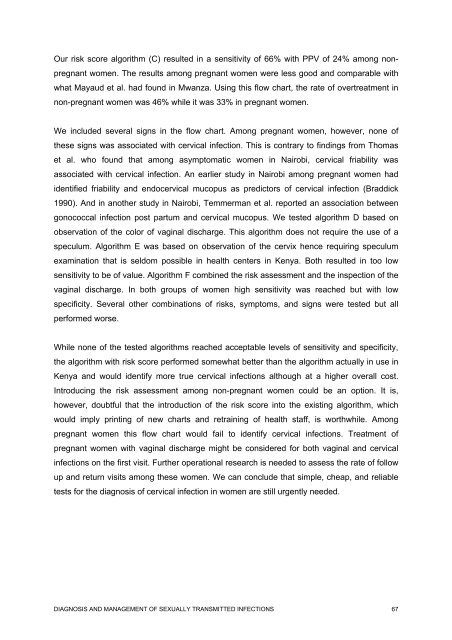GHENT UNIVERSITY Karoline FONCK - International Centre for ...
GHENT UNIVERSITY Karoline FONCK - International Centre for ...
GHENT UNIVERSITY Karoline FONCK - International Centre for ...
You also want an ePaper? Increase the reach of your titles
YUMPU automatically turns print PDFs into web optimized ePapers that Google loves.
Our risk score algorithm (C) resulted in a sensitivity of 66% with PPV of 24% among nonpregnant<br />
women. The results among pregnant women were less good and comparable with<br />
what Mayaud et al. had found in Mwanza. Using this flow chart, the rate of overtreatment in<br />
non-pregnant women was 46% while it was 33% in pregnant women.<br />
We included several signs in the flow chart. Among pregnant women, however, none of<br />
these signs was associated with cervical infection. This is contrary to findings from Thomas<br />
et al. who found that among asymptomatic women in Nairobi, cervical friability was<br />
associated with cervical infection. An earlier study in Nairobi among pregnant women had<br />
identified friability and endocervical mucopus as predictors of cervical infection (Braddick<br />
1990). And in another study in Nairobi, Temmerman et al. reported an association between<br />
gonococcal infection post partum and cervical mucopus. We tested algorithm D based on<br />
observation of the color of vaginal discharge. This algorithm does not require the use of a<br />
speculum. Algorithm E was based on observation of the cervix hence requiring speculum<br />
examination that is seldom possible in health centers in Kenya. Both resulted in too low<br />
sensitivity to be of value. Algorithm F combined the risk assessment and the inspection of the<br />
vaginal discharge. In both groups of women high sensitivity was reached but with low<br />
specificity. Several other combinations of risks, symptoms, and signs were tested but all<br />
per<strong>for</strong>med worse.<br />
While none of the tested algorithms reached acceptable levels of sensitivity and specificity,<br />
the algorithm with risk score per<strong>for</strong>med somewhat better than the algorithm actually in use in<br />
Kenya and would identify more true cervical infections although at a higher overall cost.<br />
Introducing the risk assessment among non-pregnant women could be an option. It is,<br />
however, doubtful that the introduction of the risk score into the existing algorithm, which<br />
would imply printing of new charts and retraining of health staff, is worthwhile. Among<br />
pregnant women this flow chart would fail to identify cervical infections. Treatment of<br />
pregnant women with vaginal discharge might be considered <strong>for</strong> both vaginal and cervical<br />
infections on the first visit. Further operational research is needed to assess the rate of follow<br />
up and return visits among these women. We can conclude that simple, cheap, and reliable<br />
tests <strong>for</strong> the diagnosis of cervical infection in women are still urgently needed.<br />
DIAGNOSIS AND MANAGEMENT OF SEXUALLY TRANSMITTED INFECTIONS 67




